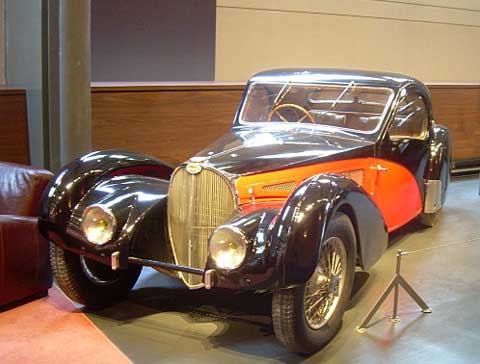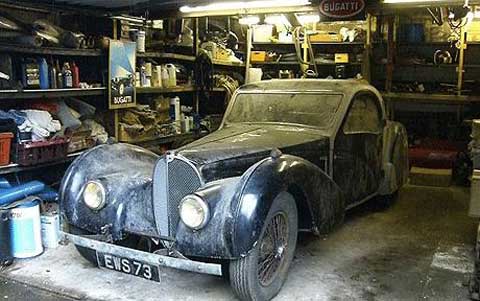 A T57S at the Schlumpf Collection in France, similar to the Bugatti found in Newcastle. Note the low cut grille and the low profile of the car itself, made possible by a redesigned frame. Photo by Lorenzo Marchesini.
A T57S at the Schlumpf Collection in France, similar to the Bugatti found in Newcastle. Note the low cut grille and the low profile of the car itself, made possible by a redesigned frame. Photo by Lorenzo Marchesini.
The full story of the Newcastle Bugatti
By Pete Vack and Staff
We first heard of the latest barnyard Bugatti on January 1st, in a blurb published by the newspaper website Telegraph co.uk.
“Doctor leaves secret £6 million Bugatti in his will†said the headlines, while Bonham’s (who will handle the sale at the Paris Retro on February 7th) hailed it as “…absolutely one of the last great barn discoveries.†But as the story unfolded, we did wonder what all the fuss was about, as the ‘secret’ barnyard Bugatti was well known.
A cow, horse or farm was nowhere in sight of the garage in Newcastle where the fabled Bugatti Atalante was parked, and the car, as well as Doctor Carr and his penchant for secrecy, have been well known for years, and years, and years. According to Sandy Leith, editor of the 2003 (the most recent) American Bugatti Register and Data Book, “Everyone in the Bugatti world knew about the Carr T57S. It has been listed in every international Bugatti register as well as all three UK Registers with Dr. Carr’s address.â€
Pierre-Yves Laugier, author of the two volume “ Bugatti 57 Sport, Volumes I and II,†(English Translation by Alexandria Taylor-Fatio, assisted by Elisa Roh, 2004, Editions BugattiBook, Switzerland, edited by Jean-Louis Fatio and Lionel Decrey) found out quite a bit about the Doctor’s coupe, but not everything. After buying the car, chassis 57502, engine 26S, from Viscount Ridley in 1955, “Dr. Carr, with the approach of any self-respecting psychiatrist, (a Yahoo news story claimed Carr was an orthopedic surgeon-ed.) took the 57S completely apart in order to better understand it. To this day, the car has still not been rebuilt, and for more than forty years, its parts have been lined up on Dr. Carr’s shelves. We therefore were not able to inspect it, but not because we did not try to contact Dr. Carr. The 57S is simply jealously guarded and has not yet surrendered its secrets.”
 The Carr Bugatti as found in the garage. According to Pierre Yves Laugier, the engine has been in pieces for years. Credit North News and Pictures LTD.
The Carr Bugatti as found in the garage. According to Pierre Yves Laugier, the engine has been in pieces for years. Credit North News and Pictures LTD.
According to Carr’s relatives, when the house was cleared, dozens of notes from would-be buyers of the Bugatti were found. “He got notes pushed through the door, people traveled from all over the country and convince him to sell the car,†said a nephew.
The line of Bugattis can be confusing and there is no one primary source to refer to for full information, chassis numbers, production records, and coachbuilders, but there are a number of Bugatti Registers and some excellent model-type books such as Laugier’s. The nomenclature is obscure as well. The T57 SC Atlantic is sometimes confused with the T57 S Atalante, for example, and what is the real difference between a T57, T57 S, and a T57 SC? The Doctor’s T57 is an S model, which is lower, faster and in general the “sports†chassis, hence the S. Or more likely, the “S†might stand for “Surbaisse,” or “especially lowered†as claimed by L. G. Matthews, Jr., in his book “Bugatti Yesterday and Today: The Atlantic and Other Articlesâ€, published in 2004 by Editions SPE-Barthélémy, Paris.
The C indicated it was supercharged, which Chassis 57502 was not. The name Atalante was given to a series of cars with factory coachwork built from 1935 to 1939, and named, according to Jonathan Wood in “Bugatti: The Man, and the Marque†(1992 Crownwood Press Ltd.) for the Arcadian heroine of Greek mythology, “renowned for her fleetness of footâ€. The Telegraph reported seventeen such cars were built, and Laugier writes that “The last 2-seater Bugatti bodied by the factory was indeed the Atalante Type 57S Coupe, of which seventeen copies were produced.”
The history of Doctor Carr’s Atalante was straightforward and notable in that it was sold to Lord Howe and delivered in Amersham, Great Britain, in June 1937. “ …The 57S was painted in two tones black with blue sides…all of Lord Howe’s touring cars were black and blue. (read about Lord Howe and the Delage ) The blue sides on the Atalante 57S were Lord Howe’s signature,†wrote Laugier. In 1947, the car was bought by John P. Tingay from the East Coast in Middlesex, who modified it with a Marshall K200 compressor, making it in effect a T57SC (although Bugattis used Roots superchargers). In the 1950s the car went to Viscount Ridley before being purchased by the mysterious Doctor Harold Carr.
As the story goes or as the Telegraph tells it, Carr, a bachelor, died in June of 2007 (that’s a year and a half ago) and left his garage and the contents to his nephews and nieces. The hoard includes an E Type Jag and an Aston Martin. The family has decided to put the Bugatti up for auction through Bonham’s. According to a nephew quoted in the Telegraph, “No-one had any idea what kind of cars he had parked in there. We knew he had some cars, but we had no idea what they were.â€
Our thanks to Sandy Leith, Patricia Lee Yongue, and Cindy Meitle.
43 examples of the T.57S chassis were made, including the 3 dramatic “Atlantic” coupes. Two T.57SC left the Molsheim factory with compressors and 13 were latter updated with that device.
Lorenzo Marchinesi’s picture shows 57451, one of the nine T.57S (with different configurations and bodybuilders)presented at the Musee National de l’Automobile, Collection Schlumpf, in Mulhouse; close to the Swiss and German borders.
I visited that museum almost 10 times since day one (the strike) up to now, always with a great pleasure: the best in its category
Actually there is one book which includes an incredible amount of information on Bugattis, including an apparently complete list of serial numbers, with coachwork and the name of the customer. This is “Bugatti Magnum,” by Hugh Conway, published in 1989. It’s over 550 pages, with detailed information on all things Bugatti. It’s out of print, hard to find and expensive, but is THE Bugatti reference book.
By now I’ve read probably a dozen articles on the “find”. As usual, yours is the most informative. But in all the blurbs I haven’t seen any reference to what model the Aston is. I suppose standing in the shadow of a T57 is tough but it’s still an Aston; Not inconsequential in it’s own right. Any info?
I read in an airport magazine in LA that the Aston was a late DB6 model in absolutely perfect condition – which would bring also a bog amount at an auction, especially Bonhams!
Who knows – after Feb. 7th should be more news regarding the “Other” cars!
Bugattistes in search of the mentioned “Magnum” and other books on The Marque would be well advised to contact me,as I have more Bugatti titles for sale than any other source in the world.